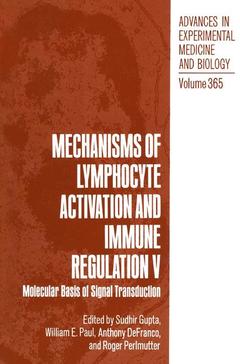Mechanisms of Lymphocyte Activation and Immune Regulation V, Softcover reprint of the original 1st ed. 1994 Molecular Basis of Signal Transduction Advances in Experimental Medicine and Biology Series, Vol. 365
Langue : Anglais
Coordonnateurs : Gupta Sudhir, Paul William E., DeFranco Anthony, Perlmutter Roger

Signaling through antigen receptor initiates a complex series of events resulting in the activation of genes that regulate the development, proliferation and differentiation of lymphocytes. During the past few years, rapid progress has been made in understanding the molecular basis of signaling pathways mediated by antigen and cytokine receptors. These pathways involve protein tyrosine kinases which are coupled to downstream regulatory molecules, including small guanine nucleotide binding proteins (e. g. p21'OS), serine threonine kinases (e. g. , members of the ERK family), and a large group of transcription factors. More recently, there have been breakthroughs in elucidating the genetic defects underlying three X-linked primary immunodeficiency diseases in humans. This volume surveys aspects of these rapidly developing areas of research. The book is divided into 5 different sections. Section I deals with signaling pathways in B lymphocytes. It includes a contemporary assessment of B cell antigen receptor structures, and discussion of the role of Ig-a/lg-B polypeptides in linking the antigen receptor to intracellular signal transduction pathways. The role of accessory molecules in the regulation of signaling by the B cell antigen receptor is also considered. Section II adopts a similar approach to the analysis of the antigen receptor on T lymphocytes. The importance of specialized signaling motifs in the CD3 polypeptides, mechanisms whereby these motifs may interact with the lymphocyte-specific protein tyrosine kinases, and the downstream consequences of these interactions are reviewed. In addition, the role of antigen-induced apoptosis in the generation of immunological tolerance is discussed.
Section I: Signaling by Antigen Receptors of B Cells.- Signaling and Internalisation Function of the B Cell Antigen Receptor Complex.- Mechanism of B Cell Antigen Receptor Function: Transmembrane Signaling and Triggering of Apoptosis.- B-Cell Activation by Wild Type and Mutant Ig-? Cytoplasmic Domains.- Accessory Molecules Which Influence Signaling Through B Lymphocyte Antigen Receptors.- Section II: Signaling by Antigen Receptors of T Cells.- Analysis of the (YXXL/I)2 Signalling Motifs Found in the Cytoplasmic Segment of the Mouse CD3-? Chain.- Molecular and Genetic Insights Into T Cell Antigen Receptor Signal Transduction.- Signal Transduction During T Cell Development.- The Regulation and Function of p21Ras in Signal Transduction by the T Cell Antigen Receptor.- Immunological Tolerance by Antigen-Induced Apoptosis of Mature T Lymphocytes.- Section III: Signaling Components of Lymphocytes.- Properties of Ca Currents Activated by T Cell Receptor Signaling.- The Role of Syk in Cell Signaling.- Nonreceptor Tyrosine Kinases in Aggregation-Mediated Cell Activation.- Control of Lymphopoiesis by Non-Receptor Protein Tyrosine Kinases.- Involvement of Nonreceptor Protein Tyrosine Kinases in Multichain Immune Recognition Receptor Signal Transduction.- Phorbol Myristate Acetate-Induced Changes in Protein Kinase C Isozymes (?, ?, and ?) in Human T Cell Subsets.- Specific CD45 Isoforms Regulate T Cell Ontogeny and Are Functionally Distinct in Modifying Immune Activation.- Cloning and Characterization of NF-ATc and NF-ATp: The Cytoplasmic Components of NF-AT.- Section IV: Signaling VIA Fc Receptors and Cytokine Receptors.- Quantitative Aspects of Receptor Aggregation.- Fc Receptor Signaling.- Proximal Signals and the Control of S-Phase Entry in Interleukin-2-Stimulated TLymphocytes.- The IL-4 Receptor — Signaling Mechanisms.- Function of the Common ? Subunit of the GM-CSF/IL-3/IL-5 Receptors.- Section V: Molecular Basis of X-Linked Immunodeficiencies.- Sharing of a Common ? Chain, ?c, by the IL-2, IL-4, and IL-7 Receptors: Implications for X-Linked Severe Combined Immunodeficiency.- X-Linked Agammaglobulinemia and Bruton’s Tyrosine Kinase.- The Role of CD40 Ligand in Human Disease.- Involvement of the Protein Tyrosine Phosphatase PTP1C in Cellular Physiology, Autoimmunity and Oncogenesis.- Contributors.
Date de parution : 06-2013
Ouvrage de 264 p.
15.5x23.5 cm
Thèmes de Mechanisms of Lymphocyte Activation and Immune Regulation V :
Mots-clés :
Antigen; T cell; apoptosis; autoimmunity; cytokine; development; immunodeficiency; lymphocytes; physiology
© 2024 LAVOISIER S.A.S.



